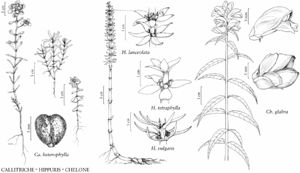Callitriche
Sp. Pl. 2: 969. 1753.
Herbs, perennial, submersed, amphibious, or terrestrial. Stems creeping or supported by water, glabrous or bearing scales. Leaves cauline, opposite, decussate; petiole present or absent; blade not fleshy, not leathery, margins entire [toothed], notched [pointed]. Inflorescences axillary, pistillate and staminate flowers sometimes in same axil; bracts present or absent. Pedicels present or absent; bracteoles present or absent. Flowers unisexual; sepals 0; petals 0. Staminate flowers solitary; stamen 1, anthers [3 or] 4-locular, filaments glabrous; staminode 0. Pistillate flowers usually abaxial to staminate, ovary superior, 4-locular, placentation basal; styles 2, erect, ascending, spreading, recurved, deflexed, or reflexed, stigma simple, terete. Fruits schizocarps, each separating into mericarps. Mericarps 4, white, maroon, brown, grayish brown, or black, reniform, wings present, partial, or absent. x = 3, 5.
Distribution
nearly worldwide, mainly montane where native in tropical regions
Discussion
Species ca. 75 (13 in the flora).
Callitriche has been included in Haloragaceae, a family now included in Saxifragales (Angiosperm Phylogeny Group 2016), and in the monogeneric Callitrichaceae, which is nested within Plantaginaceae (D. C. Albach et al. 2005).
C. F. Hegelmaier (1864) divided the genus into two sections: Callitriche (as Eucallitriche Hegelmaier) and Pseudocallitriche Hegelmaier. N. C. Fassett (1951b) emended the diagnosis and established sect. Microcallitriche Fassett. H. D. Schotsman (1967) divided the genus into five groups; one conforms to Pseudocallitriche, three to Callitriche, and one to Microcallitriche. In a comprehensive study of taxa from North America, South America, and the Mediterranean, including cytological analysis, C. T. Philbrick and D. H. Les (2000) found support for only sections Callitriche and Pseudocallitriche. All these infrageneric separations are based on a small proportion of the described taxa and almost exclusively cover taxa from Europe and the Americas.
Review of the full range of described taxa of Callitriche shows that there may be other means of subdividing the genus. For example, three Australasian terrestrial species (C. capricorni R. Mason, C. muelleri Sonder, and C. sonderi Hegelmaier) have trilocular anthers; in these species and C. cycloptera Schotsman, the filament arises from the pedicel (H. D. Schotsman 1985). Callitriche fassettii, C. hermaphroditica, C. stenoptera, and C. transvolgensis Tzvelev form a closely related group relatively distinct from their nearest relatives. Current concepts of both C. heterophylla and C. palustris include taxa that have been recognized at subspecific rank. It is likely that a comprehensive review of morphological data combined with molecular study would enable recognition of more useful groupings; to date, intermediates have been found between all subgeneric groupings.
Descriptions here refer to aquatic or amphibious forms except for Callitriche pedunculosa, C. peploides, and C. terrestris, which occur only as terrestrial forms. Reliable characters by which to distinguish Callitriche taxa are few. Useful characters include wings on mericarps and numbers and distributions of flowers. The presence, absence, or extent of wings on mericarps is important. Here, wing applies to a clearly differentiated structure arising from the exocarp of a mericarp. All species may have solitary flowers in pairs of axils; some species may have various combinations of pistillate and staminate flowers.
Callitriche is of considerable secondary importance in freshwater wetland systems providing habitat for many kinds of animals.
Selected References
Lower Taxa
Key
| 1 | Leaves not connate at bases (leaf bases not joined by a ridge of tissue extending across nodes); leaf and stem scales absent; bracts absent; leaves 1-veined. | > 2 |
| 2 | Pedicels 0.5–1 mm in fruit; schizocarps consistently shorter than wide; mericarps black. | Callitriche fassettii |
| 2 | Pedicels 0–0.2 mm in fruit; schizocarps as long as or shorter than wide, sometimes longer than wide; mericarps brown, dark brown, or gray-brown. | > 3 |
| 3 | Mericarps dark brown, wings 0.2–0.8 mm wide, as wide as or wider than mericarp body. | Callitriche hermaphroditica |
| 3 | Mericarps brown or gray-brown, wings 0.05–0.1 mm wide, width less than mericarp body. | Callitriche stenoptera |
| 1 | Leaves connate at bases; leaf and stem scales present; bracts present or absent; leaves 1+-veined. | > 4 |
| 4 | Styles reflexed, appressed to ovary; pollen colorless. | Callitriche brutia |
| 4 | Styles erect, ascending, spreading, reflexed, recurved, or deflexed; pollen yellow. | > 5 |
| 5 | Schizocarps shorter than wide; bracts absent. | > 6 |
| 6 | Mericarps swollen at bases. | Callitriche peploides |
| 6 | Mericarps not swollen. | > 7 |
| 7 | Schizocarps (0.5–)0.6–0.7(–0.8) mm; wings 0.01–0.03 mm wide; pedicels 0.4–0.6 mm in fruit. | Callitriche terrestris |
| 7 | Schizocarps 0.7–1 mm; wings 0.06–0.2 mm wide; pedicels 0–5 mm in fruit. | > 8 |
| 8 | Mericarp wings straight. | Callitriche marginata |
| 8 | Mericarp wings curled, giving appearance of thickened margins. | Callitriche pedunculosa |
| 5 | Schizocarps as long as or longer than wide; bracts present, sometimes caducous. | > 9 |
| 9 | Mericarps pale grayish brown. | Callitriche stagnalis |
| 9 | Mericarps black. | > 10 |
| 10 | Mericarps not winged, winged only at apex, or winged throughout but widest at apex. | > 11 |
| 11 | Schizocarps ± round, as long as wide. | Callitriche heterophylla |
| 11 | Schizocarps obovoid, usually widest distal to middle, longer than wide, sometimes as long as wide. | Callitriche palustris |
| 10 | Mericarps evenly winged throughout. | > 12 |
| 12 | Schizocarps as long as or longer than wide; pedicels 0–25 mm in fruit. | Callitriche longipedunculata |
| 12 | Schizocarps ± as long as wide; pedicels 0–0.5 mm in fruit. | Callitriche trochlearis |

